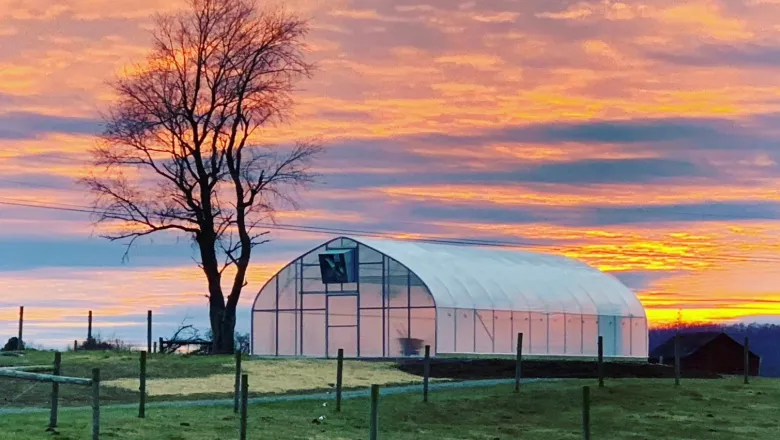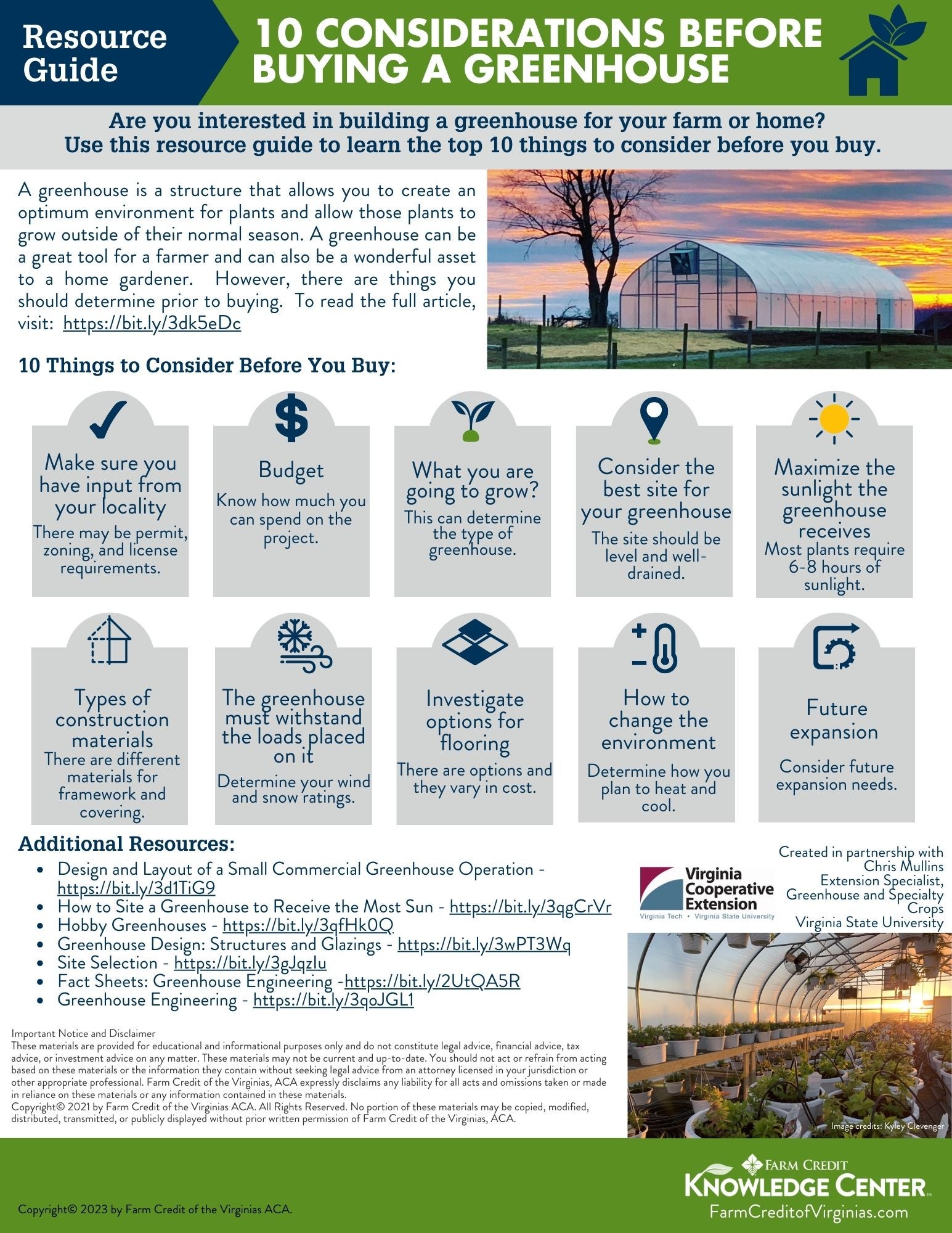10 Considerations Before Building a Greenhouse

Farm Management Resources
Young, Beginning, Small & Veteran Farmers
A greenhouse is a structure that allows you to create an optimum environment for plants and allow those plants to grow outside of their normal season. Greenhouses have been around for hundreds of years and are now used extensively all over the world to grow ornamental and edible plants. A greenhouse can be a great tool for a farmer and can also be a wonderful asset to a home gardener. If you’re thinking about building a greenhouse for your situation, I’ve put together the top 10 things to consider.
- Make sure you have input from your locality. Some cities and counties might require things like building permits, zoning permits, licenses, etc. Although some may not if you are in an agricultural zone. Ultimately each community is different, so it’s always best to check with county/city to find out what they do or don’t require.

- Budget. You should always consider what your budget is regardless of having a commercial or hobby greenhouse. As you think about some of the information below, you might find areas that will use more of your budget than others. For example, having a concrete floor would be more expensive than other types of ground cover but might be required in your situation. So, try to plan with a critical eye on your budget.
- Think carefully about what you are going to grow in the greenhouse. Crop selection can really determine what type of greenhouse to construct. The greenhouse that will be mostly for growing transplants for the home garden will be very different from the “commercial” scale greenhouse for producing tomatoes year-round. The beauty is that you can choose most anything to grow since plants do very well in the greenhouse environment.

- Consider the best site for your greenhouse. Two of the most important attributes of a good site are being level and well-drained. The location should be as level as possible as this makes construction easier and equally (if not more important) is having a well-drained site that is designed to minimize water infiltration. If these are met, you should next consider a convenient location that has easy and safe access and is close. Although greenhouses can be automated, being located close to you is always easier.
- Maximize the sunlight that the greenhouse receives. Most plants require 6-8 hours of sunlight each day. So, if you’ve gone to all the trouble to build a greenhouse, you would want it to receive as much sunlight as possible. Look for things such as buildings and trees that could cast a shade on the structure. This might include future building construction around the site or deciduous trees that might not have leaves when you are planning. You can also use sun charting apps to help determine which locations receive the best light.
- Types of construction materials. The framework (which is components like bows, purlins, ground stakes, posts, gutters and braces) on most modern greenhouses is made of steel or aluminum. The steel is usually protected from rust by a galvanizing process. The framework can also be made of wooden lumber. One of the most important construction materials is the transparent covering for the greenhouse. The three major types are polyethylene sheeting (the plastic covering that most people are familiar with), polycarbonate and glass. Glass has the highest light transmission but is the most expensive. Polycarbonate is very durable and long lived but is more expensive than polyethylene. Polyethylene is the least expensive but needs to be replaced every four years.

- Make sure the greenhouse can withstand the loads placed on it. Greenhouses are susceptible to many forces that can cause damage. Wind loads and snow loads are the most problematic. One thing you can do is make sure the structure you buy has wind and snow load ratings that meet or exceed the wind and snow amounts you typically get in your area. With snow it is important to remove the snow as quickly as possible so that your greenhouse doesn’t collapse under the weight. During high wind, make sure the plastic is not loose and the building is closed.

- Investigate options for flooring. There are a few different ways to address the floor of your greenhouse. Concrete is very durable, easy to maintain and allows easy access to carts and rolling equipment, however it is the most expensive type of greenhouse floor. Other flooring options would include river rock, stone dust, woven ground cover or a possible combination concrete walkway and rock. These require some maintenance and vary on cost.
- How to change the environment. One of the most important considerations is how to effect a change in the environmental conditions of the greenhouse. Heating can be accomplished in a few ways. Most often greenhouses are heated with a unit heater that burns liquid propane (LP) or natural gas to transfer that heat to the air in the greenhouse. These unit heaters range from 80-99% efficient. Another method of heating the greenhouse is through burning LP, natural gas or wood to heat water in a boiler. This heated water is then moved through a heat exchanger to heat the air in the greenhouse. For smaller, hobby type greenhouses electric heaters are sometimes used. Cooling is important in the warmer months and is usually accomplished with exhaust fans that pull cooler outside air through the greenhouses. Heaters and fan capacities are based on the size of the greenhouse and other factors.

- Future expansion. Consider building a slightly larger greenhouse that you think you will need. Very often growers and hobbyist quickly outgrow the first greenhouse. Some greenhouses can be expanded easier than others so investigate that factor when deciding which greenhouse to buy. Also plan ahead by looking at possible areas of expansion when deciding on a site. You can also save by putting in infrastructure such as electricity, gas and water for future expansion.
Get the PDF version of the Resource Guide.

For More Information
- https://extension.unh.edu/resource/how-site-greenhouse-receive-most-sun
- https://extension.uga.edu/publications/detail.html?number=B910&title=Hobby%20Greenhouses
- https://ag.umass.edu/greenhouse-floriculture/fact-sheets/design-layout-of-small-commercial-greenhouse-operation
- https://ceac.arizona.edu/resources/greenhouse-design
- https://ufdcimages.uflib.ufl.edu/IR/00/00/16/83/00001/CV25300.pdf
- https://ag.umass.edu/greenhouse-floriculture/fact-sheets/greenhouse-engineering
- https://ecommons.cornell.edu/bitstream/handle/1813/69429/NRAES-033.pdf?sequence=1&isAllowed=y
Author:
Chris Mullins
Extension Specialist, Greenhouse and Specialty Crops
Virginia State University